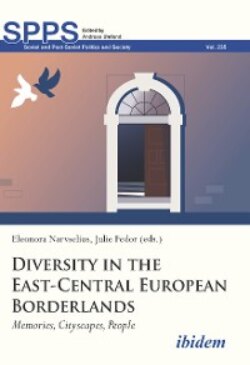Читать книгу Diversity in the East-Central European Borderlands - Группа авторов - Страница 23
На сайте Литреса книга снята с продажи.
L’viv–Lwów–Lemberg Interwar Lwów in Historical Context
ОглавлениеFrom medieval times, the Polish and Ukrainian/Ruthenian cultures met in L’viv/Lwów/Lemberg. The Ruthenian rule is represented by the “Old Town” under the High Castle Mountain, and the Polish rule (1340–1772) by the regular “New Town,” around the Rynek (market square) with the City Hall. Outside the fortifications came a girdle of monasteries, churches, and gardens. The Austrian period (1772–1918) is represented first and foremost in the boulevard and park system, replacing the former fortifications, and outside them a rapid city growth with apartments, villas, parks,53 industries, and a large number of monumental buildings. As capital of the Kingdom of Galicia and Lodomeria with the Duchies of Auschwitz and Zator within the Habsburg Empire, Lemberg was a major center of Polish, Ukrainian, and Jewish culture, and had, like Chernivtsi, a distinctly Central European character.54 Polish replaced German as the official language in 1867. Later, the integrated Jewish population changed from German to Polish. The Greek Catholic St. George Cathedral and the “Dnister” building were the main centers of Ukrainian culture. World War I resulted in growing ethnic conflicts, mistrust, and violent confrontations between Poles and Ukrainians. In 1918, a bloody pogrom was staged (Wierzbieniec 2005: 239; Mick 2016: 47; Amar 2015: 31).
Figure 2.7. L’viv. Streets where property owners or business activities were registered in 1929 and in some cases earlier, based on archival material. Map by the author. The background is from a 1936 map, found at Mistoproiekt urban planning office in L’viv and scanned and provided by Vitaliy Shulyar, participant in the Memory of Vanished Population Groups research project, in 2012.
Interwar Lwów remained a vital city, growing in 1921–31 from 219,000 to 310,000 inhabitants, 31.2% Jewish and 16% Ukrainian (mostly Greek Catholic). An address book from 1929 shows that the northwest area contained many small Jewish enterprises like shops, tailors, carpentry and masonry workshops, restaurants, and pubs. Better-off citizens, mostly Poles and emancipated Jews, inhabited streets west and south-west of the Old Town, like Jagiellońska, Akademicka, and Leona Sapiehy. Rynek and the boulevards Legionów and Akademicka were centers of commercial and cultural life with numerous cafés and restaurants. Nearby streets had a concentration of bookstores, antiquarians (especially on Batorego Street, most of them Jewish), and newspaper and journal editorial offices.
Krakowska, Halicka, and Rutowskiego streets were known for their numerous fashion stores.55 Café Roma at Akademicka and Atlas at Rynek were popular meeting places. Modernist architecture broke through in the exhibition “Living and City” in 1926. L’viv has many excellent examples of interwar modernism, among them the Sprecher building at Akademicka and several apartment buildings.56
Figure 2.8. L’viv. Buildings and business activities in 1929 and earlier around Rynek (present Ploshcha Rynok). Map by the author. Background map from 1936, details as for Figure 7.
Figure 2.9. L’viv. Buildings and business activities in 1929 along the middle part of Ulica Zamarstynowska (present Vulytsya Zamarstynivs’ka). Map by the author. Background map from 1936; details as for Figure 2.7. Ulica Zamarstynowska was the ghetto limit in 1942–43. The western side was part of the ghetto area.
